Solar Energy: Technology Overview
In the last weeks I did intensive research about solar energy and collected a lot of information about the topic.
I have summarized the results for you in this article.
I had the following questions:
- Which solar panel brings the best performance?
- Which charge controller do I need?
- Which battery type is right for me?
At the End of this Post you can read, how I answered these questions for myself.
Which solar panel gives the best performance?
Polycrystalline or monocrystalline?
Monocrystalline solar modules have more power on the same area than polycrystalline modules have, but polycrystalline modules are slightly cheaper. Polycrystalline modules lose less power over their lifetime than monocrystalline modules. On warm days, the power loss of polycrystalline modules is lower, because monocrystalline cells heat up more due to their black color. The power of solar modules decreases with increasing temperature. Monocrystalline modules, on the other hand, achieve a slightly higher yield on cloudy days.
What does Back Contact mean?
In Back Contact solar cells, the conductors are placed on the back side, this allows more light to hit the cells and more energy is generated (about 2%).
What does shingle technology mean?
In shingling, the individual solar cells are laid on top of each other inside like roof tiles. This allows the surface to be used more effectively and increases the performance of the solar module. In addition, the performance of the solar panel also increases when parts are in the shade. With shingle modules, the cells that are not shaded remain active!
Which charge controller do I need?
PWM or MPPT?
PWM (pulse width modulation) is basically a direct connection between the solar module and the battery. In this process, the voltage of the solar module almost collapses to the voltage of the battery. When the battery is fully charged, the controller disconnects the solar module from the battery. When the battery voltage drops, the solar module is reconnected. This process can occur several times per second.
PWM controllers are much cheaper than MPPT controllers.
With MPPT (Maximum Power Point Tracking), the controller searches for the highest power point in the solar module’s power curve, then the solar module’s voltage is transformed to the battery voltage. This is so effective that, despite losses due to voltage transformation, significantly more energy still reaches the battery than with a PWM controller.
In environments with moderate temperatures and fluctuations in light intensity, an MPPT regulator brings up to 30% more energy into the battery. For LiFePo4 batteries, MPPT controllers should be used in any case.
Should I connect several solar panels in parallel or in series?
Advantages of series connection: When it is cloudy or shady, the voltage (V) of a solar module can drop low so that it is no longer sufficient to charge a battery. In this case a series connection of several modules can help to increase the voltage (V) so that charging is possible again.
A bypass diode must be installed to bridge shaded areas. In addition, an MPPT controller is needed to adjust the fluctuating voltage (V) for the battery.
Advantages of parallel connection: If there is enough sun, the solar modules in a parallel connection supply more current (A) and can therefore charge the battery faster. However, it is important to check how high the maximum charging current of the batteries may actually be. This is significantly lower for AGM than for LiFePo4 batteries.
Which battery type suits me?
Gel, AGM or LiFePo4?
Gel Battery
In a gel battery, the positive and negative electrodes are surrounded by electrolyte, as in a conventional wet battery (e.g. car battery). However, the electrolyte is not in liquid form, but has been converted to a gel-like state. This makes gel batteries safer and less sensitive. Gel batteries can be installed in any position and are relatively insensitive to shock. If the battery is undamaged, there is no risk of fluid leakage. A gel battery is therefore often referred to as a maintenance-free battery.
Strengths of gel batteries:
- Gel batteries are more resistant to high temperatures than AGM batteries.
- Lifetime is not quite as long as a LiFePo4 battery, but longer than an AGM battery
Disadvantages of gel batteries:
- Gel batteries do not tolerate low temperatures well
- Gel batteries need to be fully charged at regular intervals
AGM Battery
AGM stands for Absorbent Glass Mat. In these batteries, the electrolyte is completely bound in a glass fiber mat. The AGM battery is also leak-proof and can also be installed in any position. The AGM battery is also sealed and is also considered maintenance free. The biggest advantage of the AGM battery over the gel battery is the higher starting power and cold stability.
Maintenance-free for gel and AGM batteries means, above all, that there is no need to refill with distilled water.
Advantages of AGM batteries:
- Even at lower temperatures, the AGM battery works reliably
- Lower self-discharge than gel batteries
- Applications with high currents possible (e.g. starter battery in cars, emergency power supply (UPS))
Disadvantages AGM batteries:
- High temperatures = high capacity loss
- The loss of capacity of an AGM battery in case of a deep discharge is even greater than that of a gel battery
Special notes about gel and AGM batteries:
- Do not discharge the battery more than 30% (otherwise life expectancy drops significantly)
- AGM batteries have a lower capacity if they are discharged quickly (with high current (A))
- For gel and AGM batteries, the minimum charging current should be about 10% of the battery capacity
- Maximum charging current between 10% and 30% of the battery capacity
- Battery temperature increases when charging current exceeds 20%. Keyword: temperature compensation
Different manufacturers specifications vary on these parameters. Be sure to check the manufacturer’s data sheet before buying.
LiFePo4 Battery
Lithium iron phosphate batteries, also known as LiFePo4 batteries, are very efficient. Positive electrodes (lithium iron phosphate) and negative electrodes (graphite with embedded lithium) provide energy with the help of the conductive electrolyte by changing the charge. LiFePo4 batteries are often referred to as lithium-ion batteries, but this is incorrect.
LiFePO4 batteries have significant advantages over gel and AGM batteries in terms of cycle stability, size, capacity and weight. The disadvantage is the higher price on purchase of LiFePO4 batteries.
LiFePo4 batteries can also be installed in any position and are maintenance-free. They are considered extremely safe, as they do not overheat and will not start a fire even if the housing is damaged.
However, this statement regarding safety must take into account the quality of the manufacturing process, i.e. all the components that make up a LiFePo4 battery. And in the case of LiFePo4 batteries, this includes not only the cells but also the connecting material, battery management system (BMS) and other components with which a battery is finally brought to market as a finished product.
By the way, lithium batteries must be labeled as dangerous goods when shipped. Whether this applies only to lithium-ion batteries that are contained in smartphones and tablets for example, or also to LiFePo4 batteries, which are considered particularly safe, I could not find out clearly.
For LiFePo4 batteries a BMS (battery management system) is needed, this is already built into most batteries. The BMS is an electronic controller that monitors and regulates the state of the battery. It prevents short circuit and ensures safe charging and discharging of the battery. In addition, the BMS monitors the individual cells and the temperature. Some batteries even have a Blutooth interface, with which the state of the battery can be queried via app on a smartphone.
Normally, the battery management system protects the LiFePo4 batteries from deep discharge. However, if the battery is not used and charged for a long time, the battery management system may shut down due to undervoltage. For some batteries, the battery management system can be reactivated by connecting a charger, but in some cases, the support of the manufacturer or a specialist is required for reactivation.
Strengths of LiFePo4 Batteries:
- High charge and discharge currents
- High number of charge cycles (approx. 2000)
- Significantly lower weight than gel / AGM batteries
- No memory effect; partial charging possible
Disadvantages of LiFePo4 Batteries:
- High price
- Cannot be charged at low temperatures. (However, there are LeFePo4 batteries with built-in heating)
The specifications of different manufacturers also vary for LiFePo4 batteries. In any case, look at the manufacturer’s data sheet before buying.
My purchase decision
(This section may contain traces of advertising.)
I wanted portable equipment for camping and trips with a boat, that could also be left on the balcony sometimes.
Solar Panel
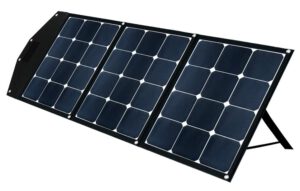 I decided to buy a foldable solar panel* I chose a variant with 120 Watt*..
I decided to buy a foldable solar panel* I chose a variant with 120 Watt*..
The solar bag has a practical carrying handle and also offers storage space for cables. It weighs just under 5 kg and delivers a maximum of 5.97 A.
According to the manufacturer, solar cells from SunPower are used. The efficiency is specified with 22%.
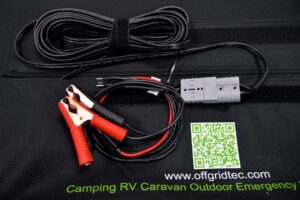 The module is delivered with a set of cables. 6.0m connection cable, which is provided at the end with an Anderson connector. Matching to this, a second 0.5m connection cable is supplied, which is screwed directly to the solar input of the charge controller, and is also equipped with an Anderson connector on the other side. This allows you to quickly connect or disconnect the controller at any time via the Anderson connectors without having to unscrew the cables from the charge controller.
The module is delivered with a set of cables. 6.0m connection cable, which is provided at the end with an Anderson connector. Matching to this, a second 0.5m connection cable is supplied, which is screwed directly to the solar input of the charge controller, and is also equipped with an Anderson connector on the other side. This allows you to quickly connect or disconnect the controller at any time via the Anderson connectors without having to unscrew the cables from the charge controller.
Charge controller
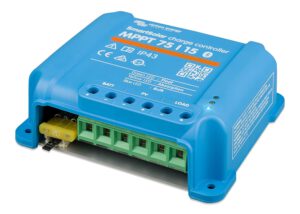 I chose an MPPT model from Victron Energy*. The charge controllers are available for different amperages (A), both for 12 volts and for 24 volts. Optionally, the charge controllers are also available with Bluetooth interface, so values can be read and settings changed via app (Android and iOS).
I chose an MPPT model from Victron Energy*. The charge controllers are available for different amperages (A), both for 12 volts and for 24 volts. Optionally, the charge controllers are also available with Bluetooth interface, so values can be read and settings changed via app (Android and iOS).
I have chosen the variant SmartSolar MPPT 75V/15A with Bluetooth*.
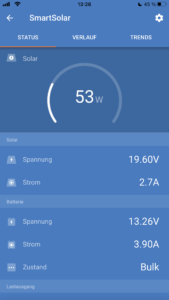
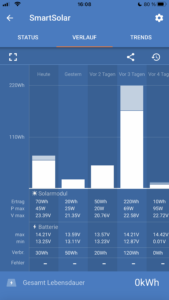
Many Victron Energy Products* have a bus system (VE.Bus) which can be used to connect components together.
The integration of a Raspberry Pi is also possible, for this Victron Energy offers its own image (GitHub: victron-energy/venus – raspberrypi-install-venus-image).
There is also a module for the home automation software FHEM for the Victron MPPT charge controllers (GitHub: Askie666 / VE.Direct – FHEM modul for Victron VE.Direct-devices).
Battery
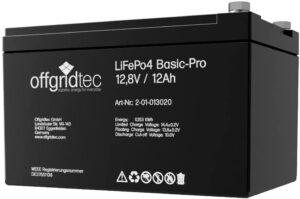 I decided to use a 12 Ah LiFePo4 Battery.
I decided to use a 12 Ah LiFePo4 Battery.
Since I do not fully charge my battery regularly, LiFePo4 seemed more suitable. Also the weight seems to be more comfortable.
For comparison: 12Ah AGM weigh 3,9 Kg, 12Ah LiFePo4 weigh 1,7 Kg.
Another reason for my decision is capacity and charging current:
With AGM batteries, I can only use 30-50% of the capacity. So I would have “felt” only a 6Ah battery.
With a discharge current of 2A, the capacity would already drop to about 10.8 Ah (felt 5.4 Ah).
If I would charge the AGM battery with the recommended 10%-20% charge current, I would need 5-10 hours to fully charge the battery, or 2.5-5 hours if I use only 50% of its capacity, as recommended.
The LiFePo4 battery, on the other hand, I can discharge up to 80% (felt 9.6 Ah) and recharge it with up to 10A (about 7A was recommended here). My 120 Watt solar panel delivers max. 5,97A. So with direct sun, I should be able to charge it in under 1.5 hours (if I use 80% = 9.6 Ah). That’s almost double the capacity at about half the weight and less charging time. Another advantage is that I can discharge the LiFePo4 battery with stronger current (A) without losing capacity.
For the Battery I have chosen: The Offgridtec LiFePo4 Basic-Pro 12/12 Battery 12Ah 12.8V 128Wh Lithium Battery*
I had no experience with the company Offgridtec* so far. I liked the clear website Webseite (www.offgridtec.com). In addition, the technical data were clearly entered for all items offered via Amazon, so that the products were easy for me to compare.
In the next few weeks, i’m going to find out how everything really works…
* marked links are affiliate links.
This Post Has 0 Comments